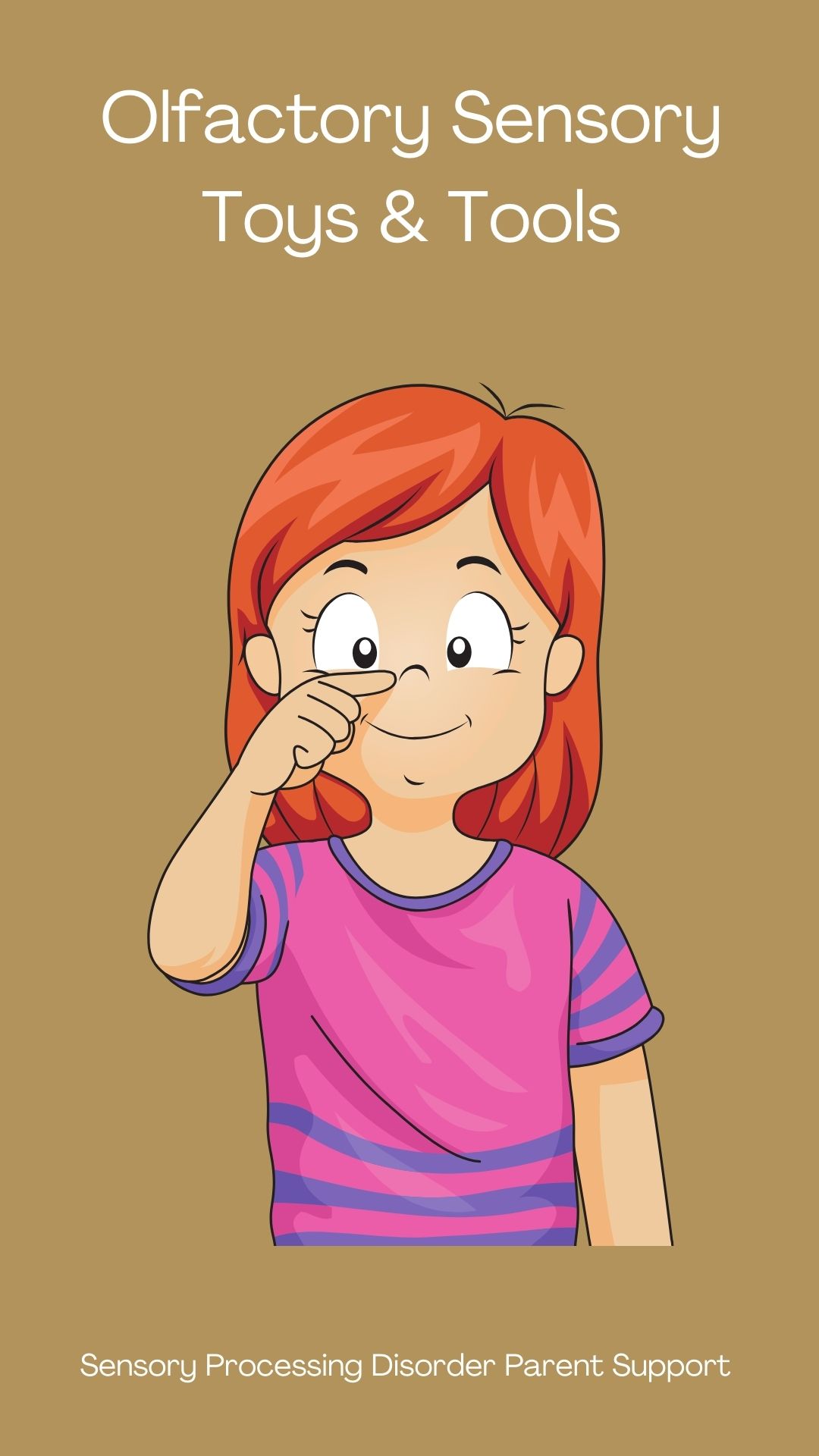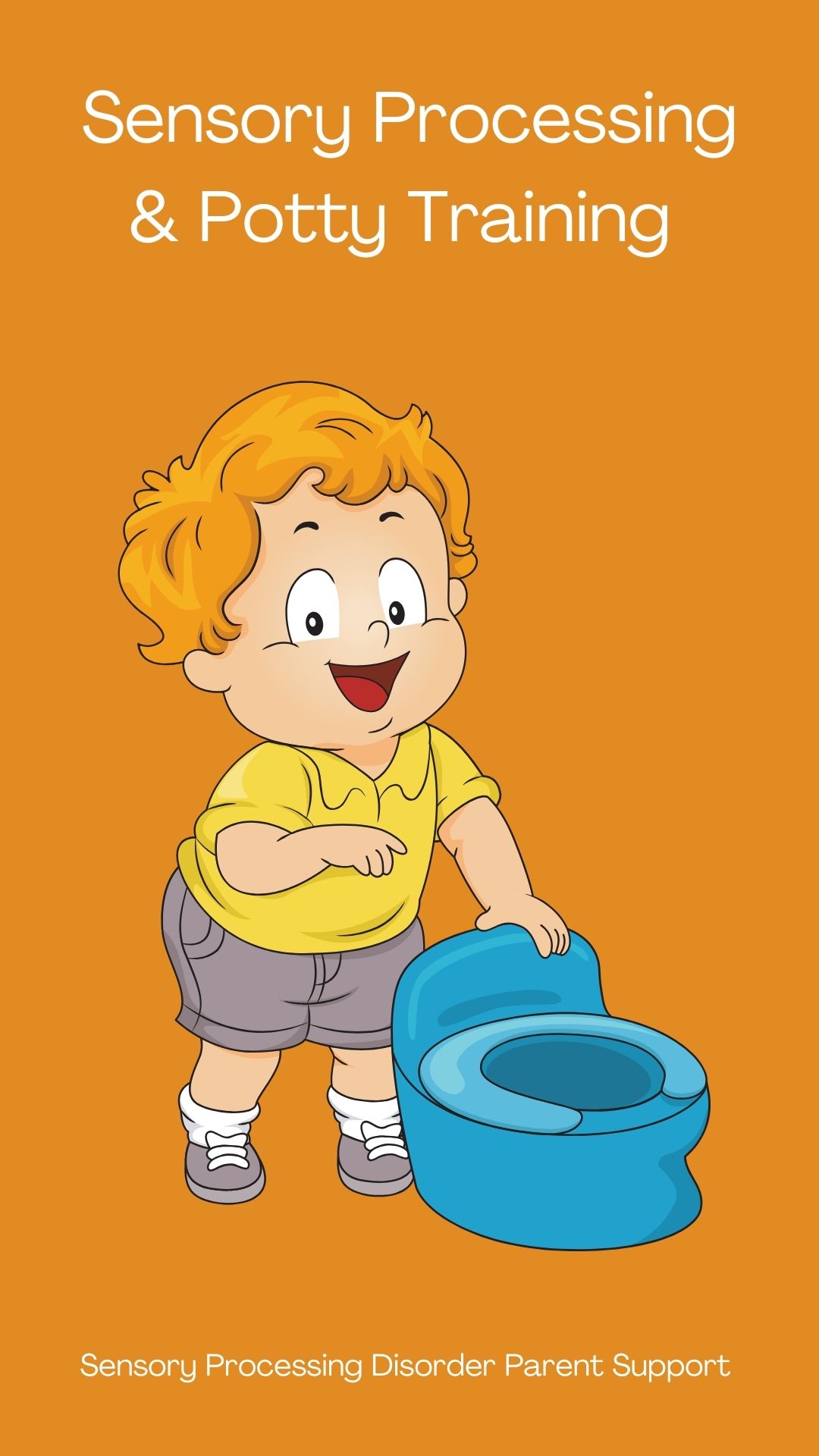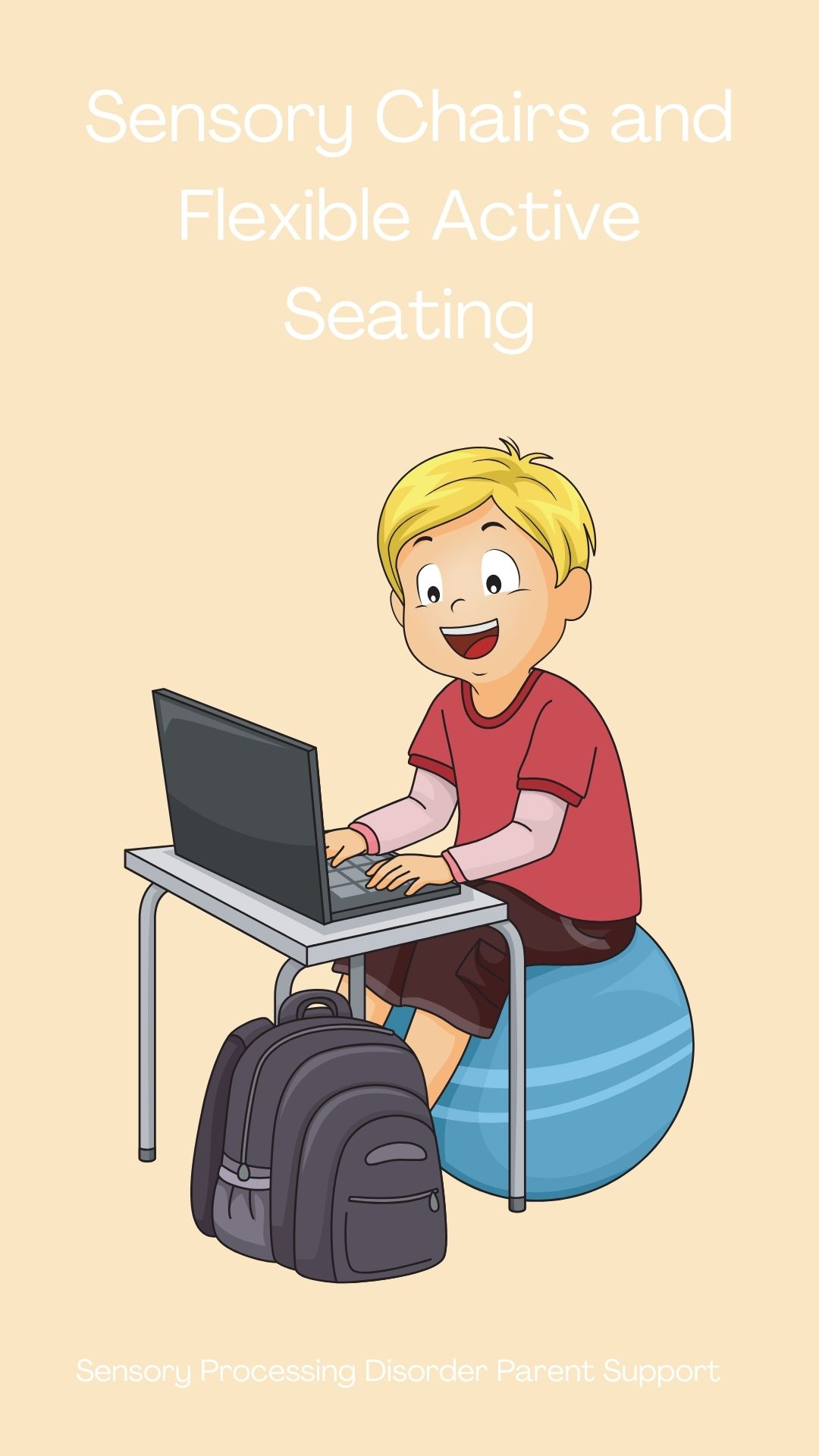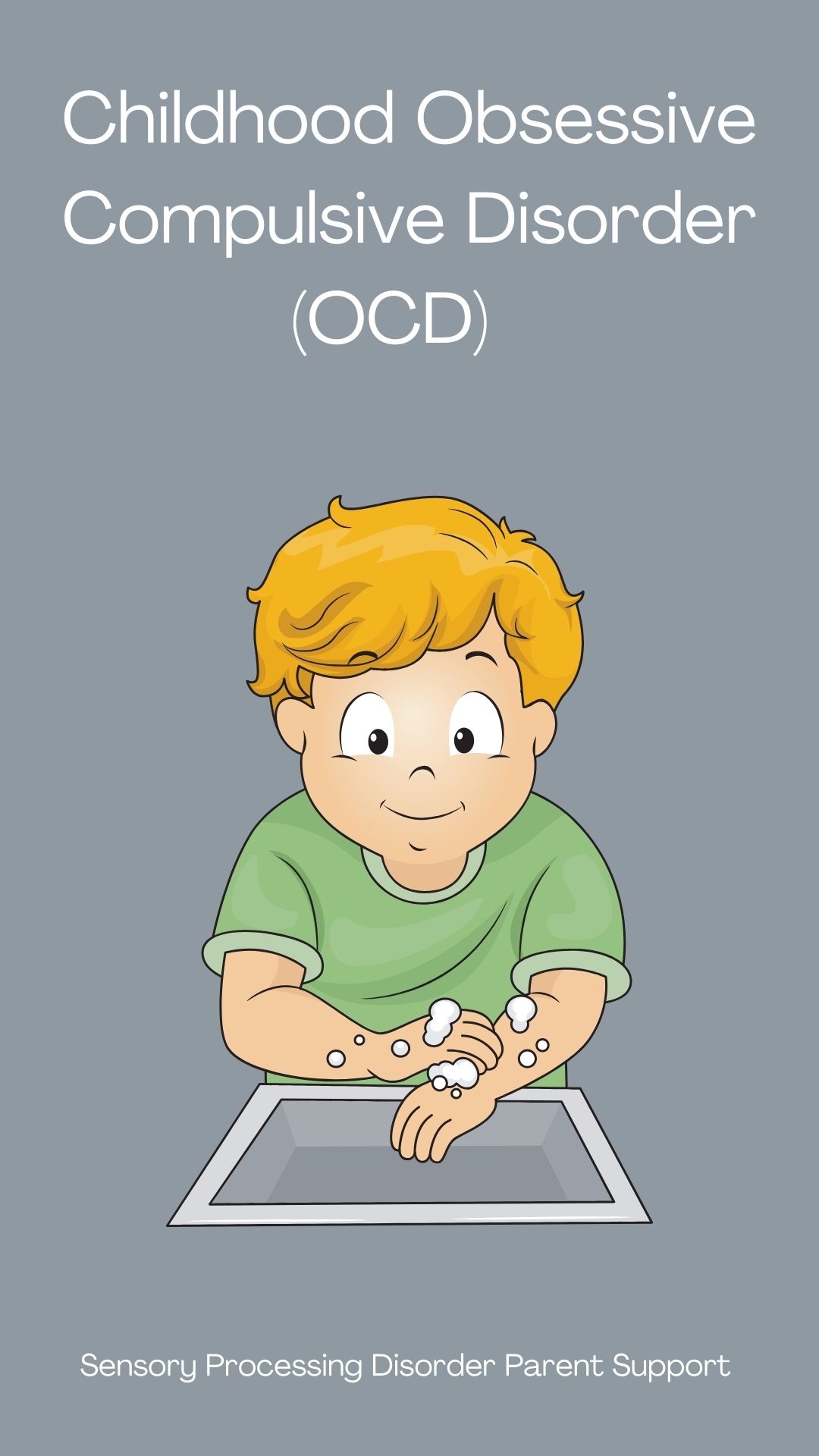
Sensory Processing Disorder Parent Support
Sensory Processing Symptoms Checklist
Children with sensory differences ... painting the world beautiful.
Sensory Processing Disorder Symptoms Checklist
Jeanette Loftus
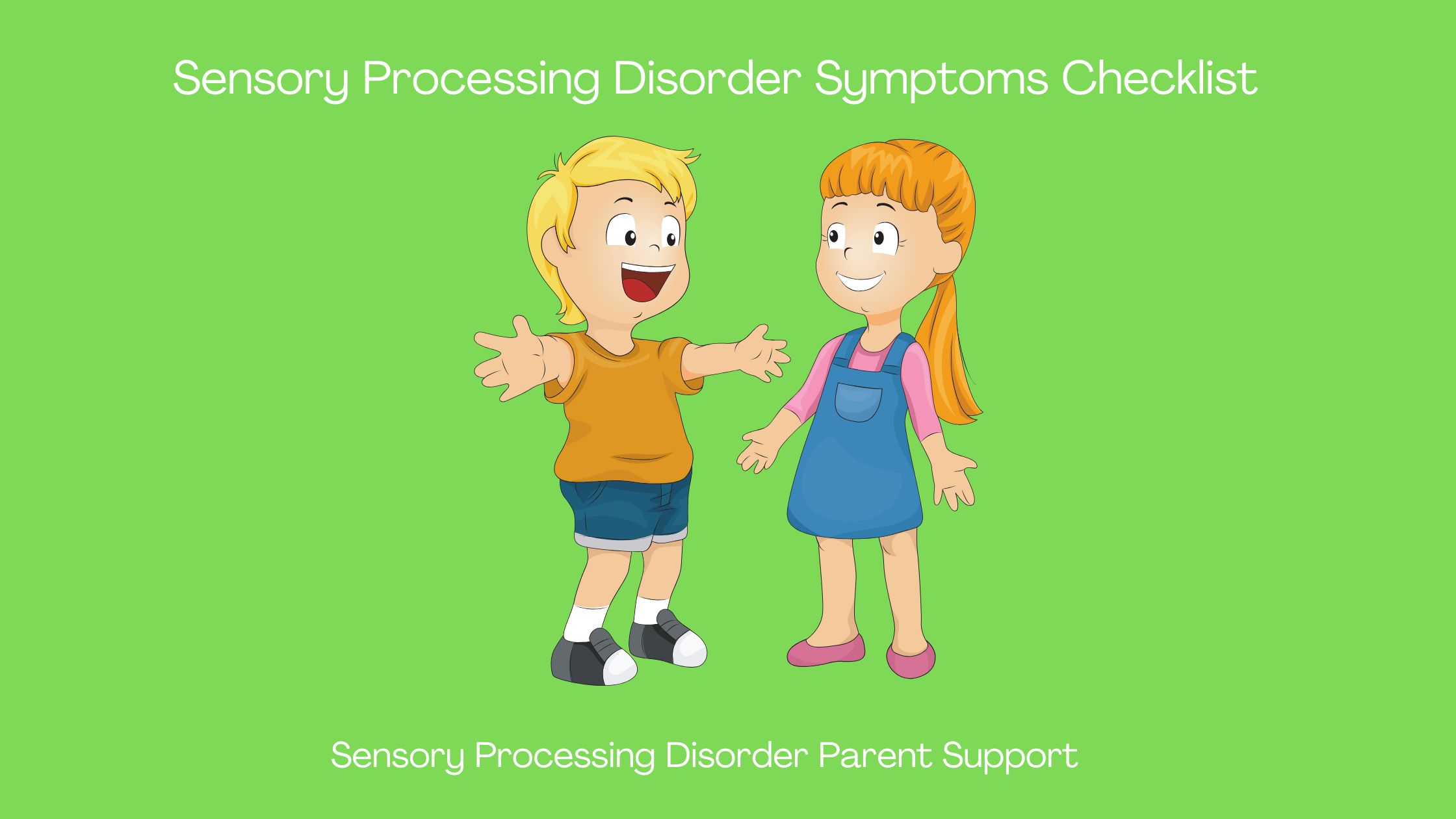
Sensory Processing Disorder (SPD) affects everyone differently. Some children can have severe symptoms and other children will have mild symptoms.
Some children can have every symptom in one sensory system category and have no symptoms in the other categories, they can also have a few symptoms from a few categories.
It is so different for everyone who has sensory processing disorder. A child could just have a few of these symptoms and still have Sensory Processing Disorder.
Sensory processing disorder symptoms can often be misunderstood or overlooked, leading to late diagnosis and treatment. To help identify potential signs of sensory differences, a sensory processing disorder checklist can be used to evaluate a child’s sensory symptoms.
The symptoms lists below are not medical forms or assessments . They are basic informational list that I have created to help you. They are for informational purposes only. If you are concerned your child may have sensory processing disorder please see an occupational therapist for a sensory assessment. This checklist cannot be used to evaluate a child’s or to determine if they have any sensory processing difficulties.
Children who have Sensory Processing Disorder usually fall into two categories, a seeker or an avoider.
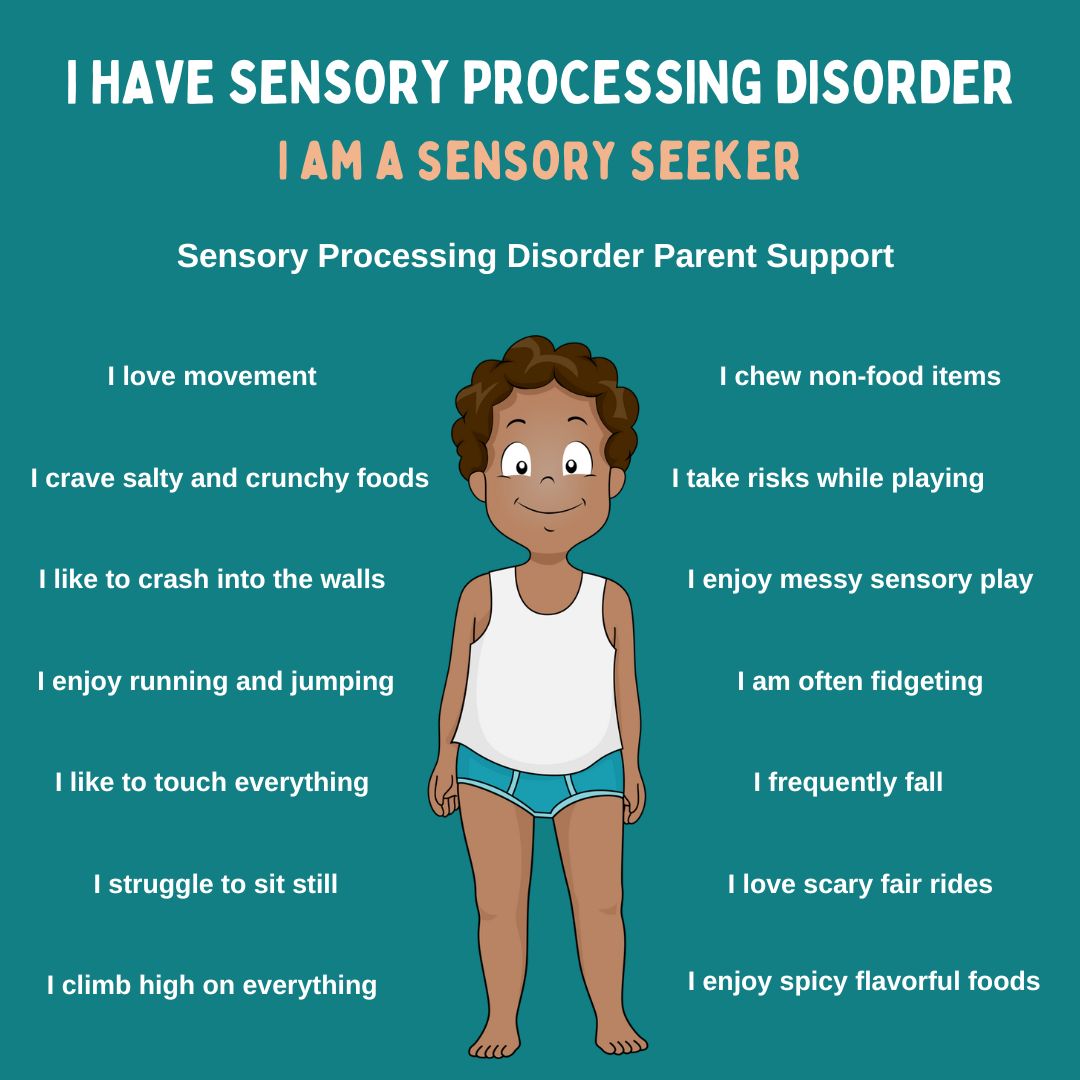
Hyposensitive means that you are less sensitive (under-responsive) to input than others. Meaning you may want and crave more input to feel regulated and fulfilled. This may look like constantly moving, spinning, jumping, or playing rough with others. At times we refer to people that are hyposensitive as seekers.
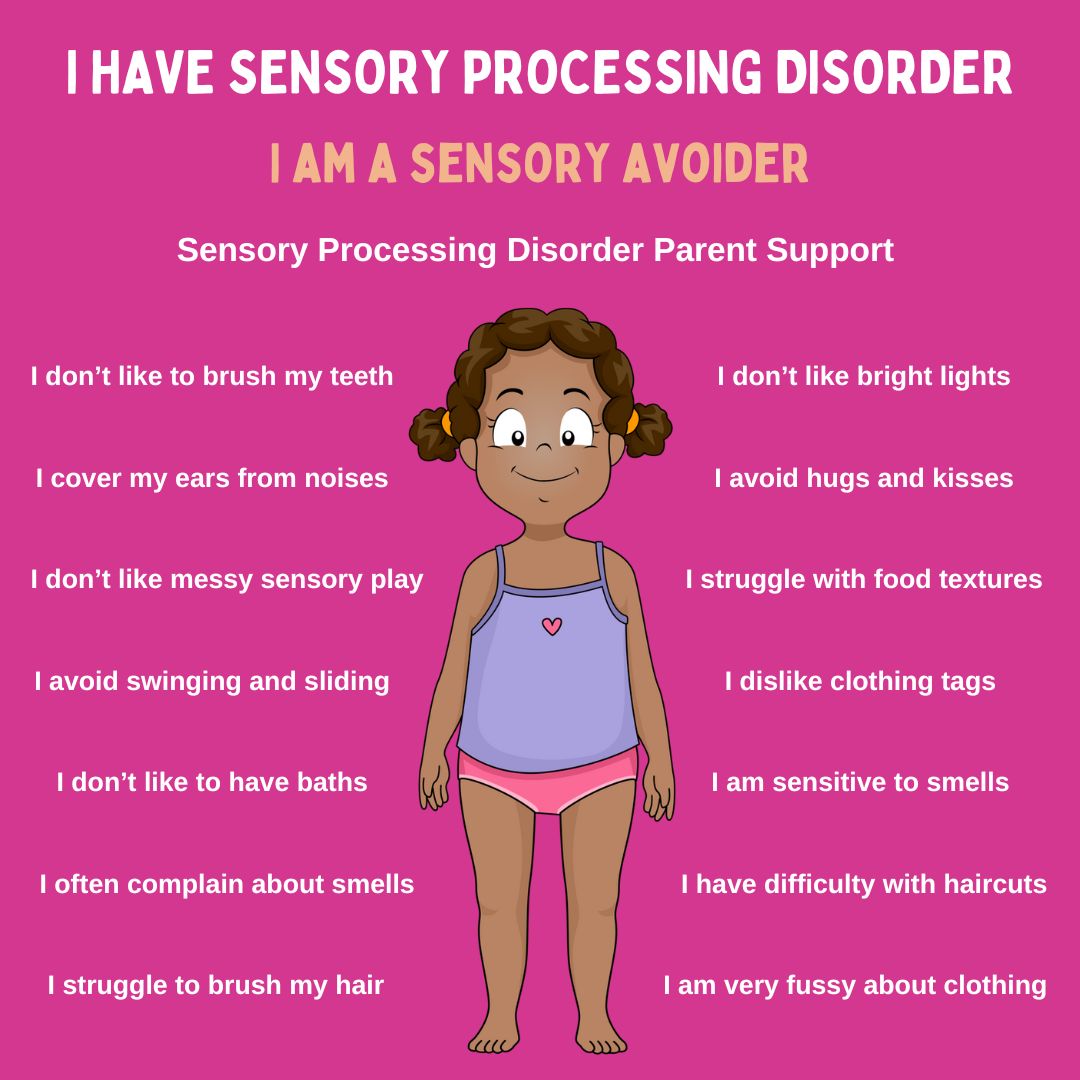
Hypersensitive means that you are more sensitive (over-responsive) to input than others. This may look like covering you r ears when a vacuum is turned on because it is too loud. Or struggling with the feeling of your clothing, even to the point of not being able to wear clothes. At times we refer to people that are hypersensitive as avoiders, they want to avoid certain types of input because they are more sensitive to them.
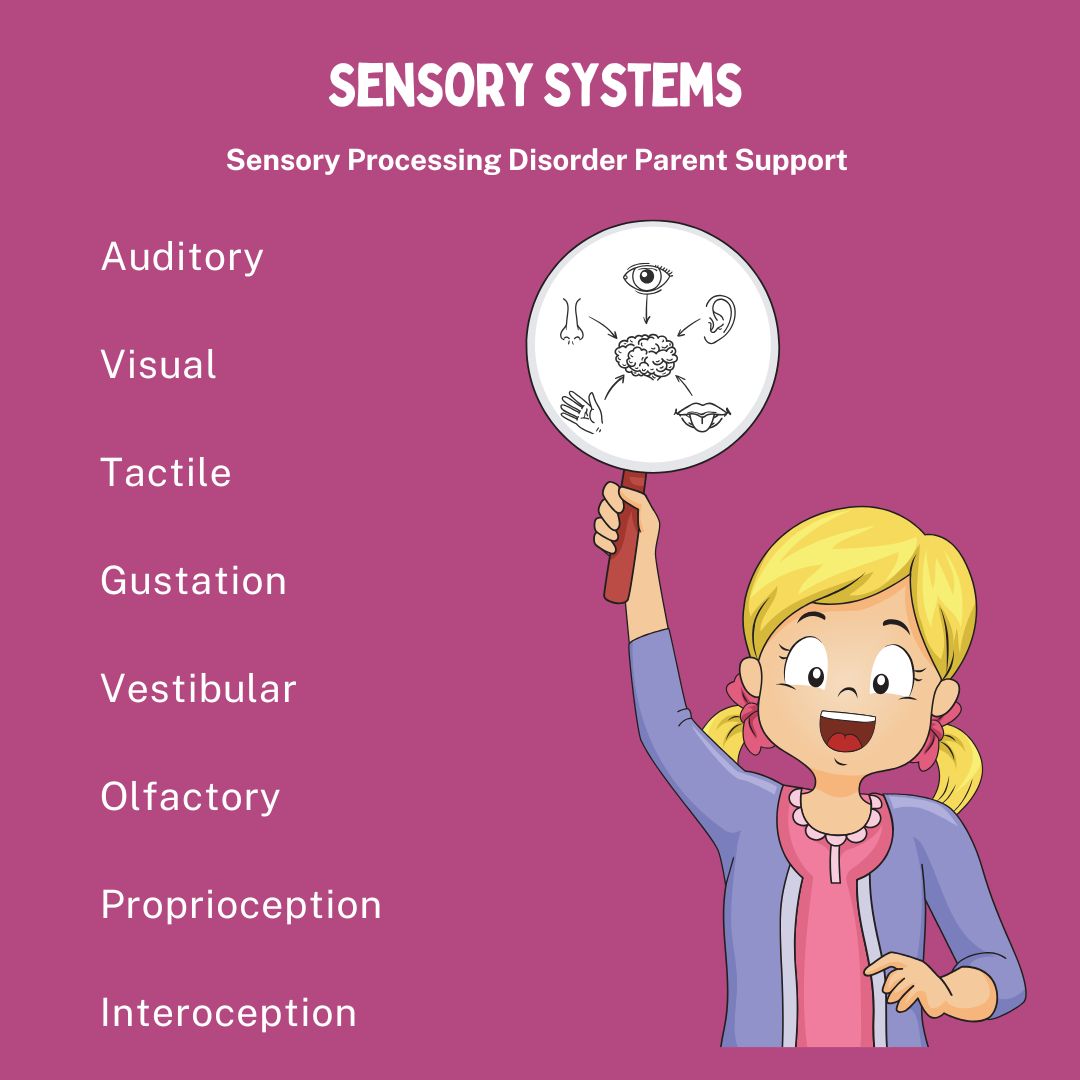
This sensory symptoms checklist is divided into different categories for each of the human senses, such as tactile (touch), auditory (sound), visual (sight), olfactory (smell), gustatory (taste), and vestibular (movement).
This sensory processing disorder checklist is not a tool to diagnose sensory processing disorder. A diagnosis should only be made by a pediatric occupational therapist or pediatrician.
They will start a sensory profile assessment for your child to determine if they struggle with sensory processing.
The sensory assessment could include different tests such as standardized assessments, sensory profile quiz, direct observations or asking parents or caregivers for more information.
Sensory Processing Disorder Symptoms Checklist
Hypersensitivity To Touch (Tactile Defensiveness) Sensory Processing Disorder Symptoms Checklist
- difficulty getting hair cuts
- avoids being touched or sitting too close to others
- resists wearing shoes, jeans, underwear or socks
- doesn't like nails being cut
- dislikes taking a shower or having a bath
- gets angry or surprised by unexpected touch
- dislikes being kissed or hugged
- avoids messy play
- refuses to eat different food textures
- avoids going barefoot in the grass
- doesn't like to wash or brush hair
- extremely ticklish
- bothered by clothing seams and fabrics
- gets upset when hands are dirty
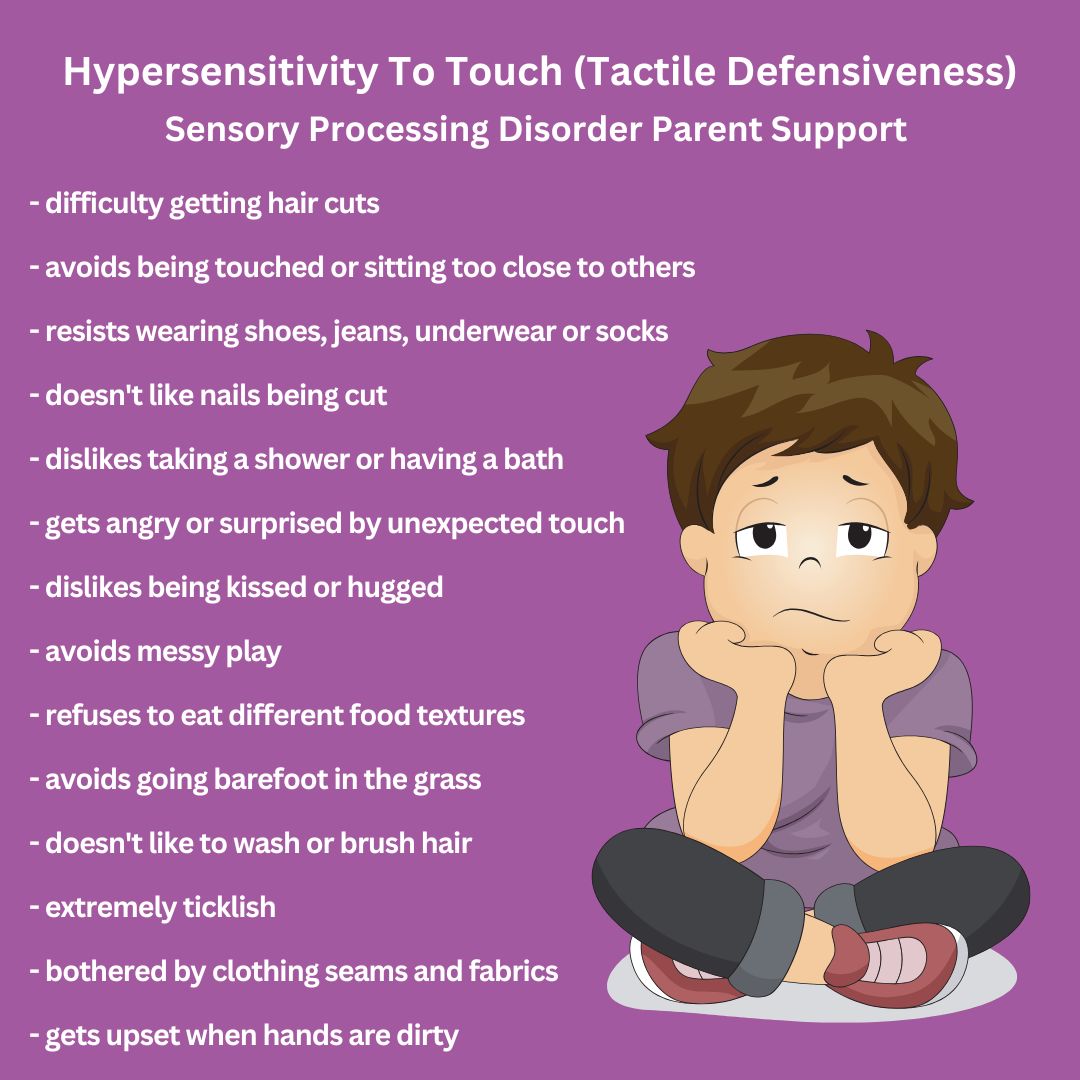
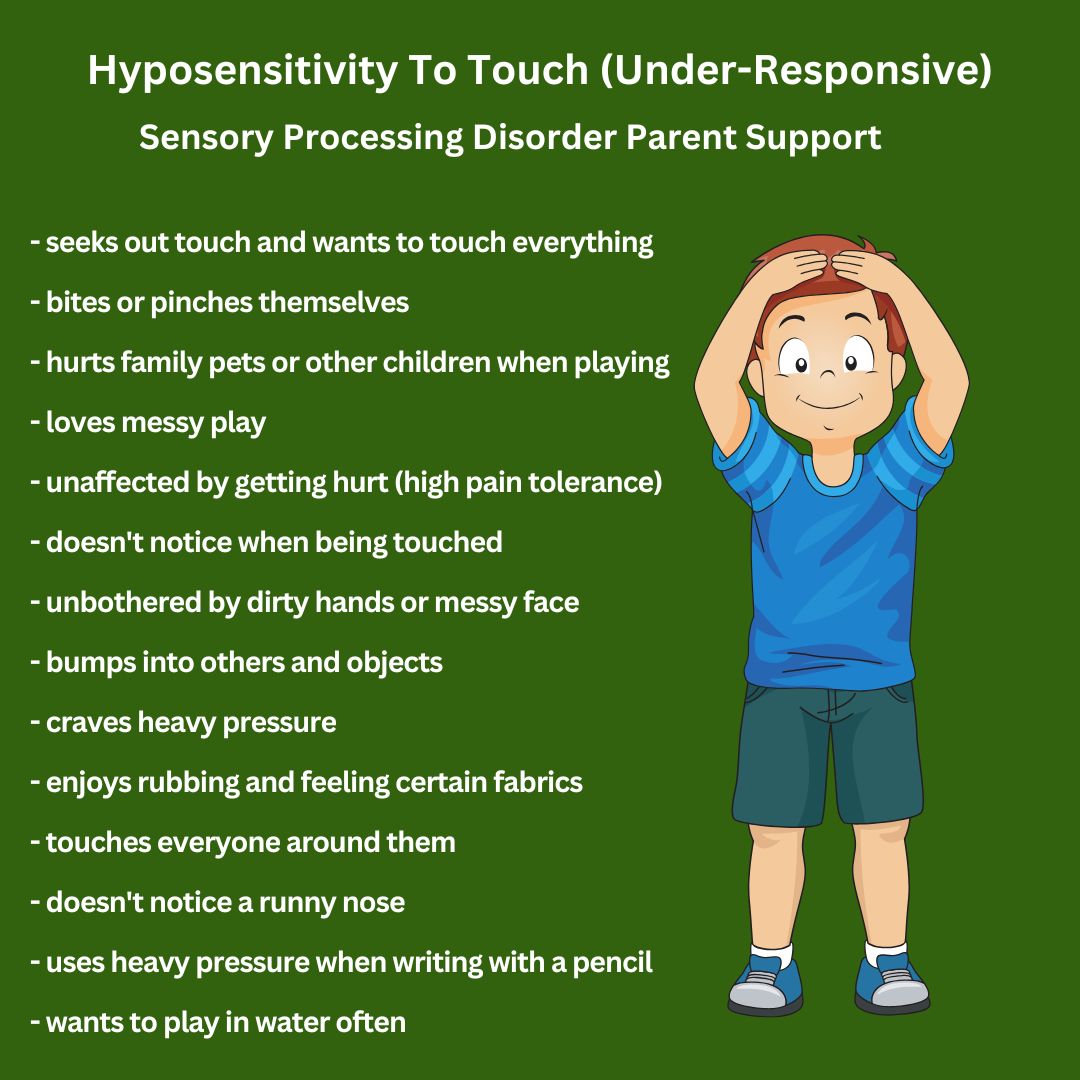
This Hyposensitivity To Touch (Under-Responsive) Sensory Processing Disorder Symptoms Checklist
- seeks out touch and wants to touch everything
- bites or pinches themselves
- hurts family pets or other children when playing
- loves messy play
- unaffected by getting hurt (high pain tolerance)
- doesn't notice when being touched
- unbothered by dirty hands or messy face
- bumps into others and objects
- craves heavy pressure
- enjoys rubbing and feeling certain fabrics
- touches everyone around them
- doesn't notice a runny nose
- uses heavy pressure when writing with a pencil
- wants to play in water often
Hyposensitivity To Movement (Vestibular) Under-Responsive Sensory Processing Disorder Symptoms Checklist
- can spin for a long time and not get dizzy
- has difficulty sitting still
- enjoys riding on scary fair rides
- would rather run, skip and jump than walk
- likes to hang upside down
- craves fast and intense movement
- enjoys rocking in a chair
- struggles to pay attention
- frequently falls and often clumsy
- prefers heights and being high in the air
- often jumps on beds or furniture
- always fidgeting
- takes risks while playing
- always in motion

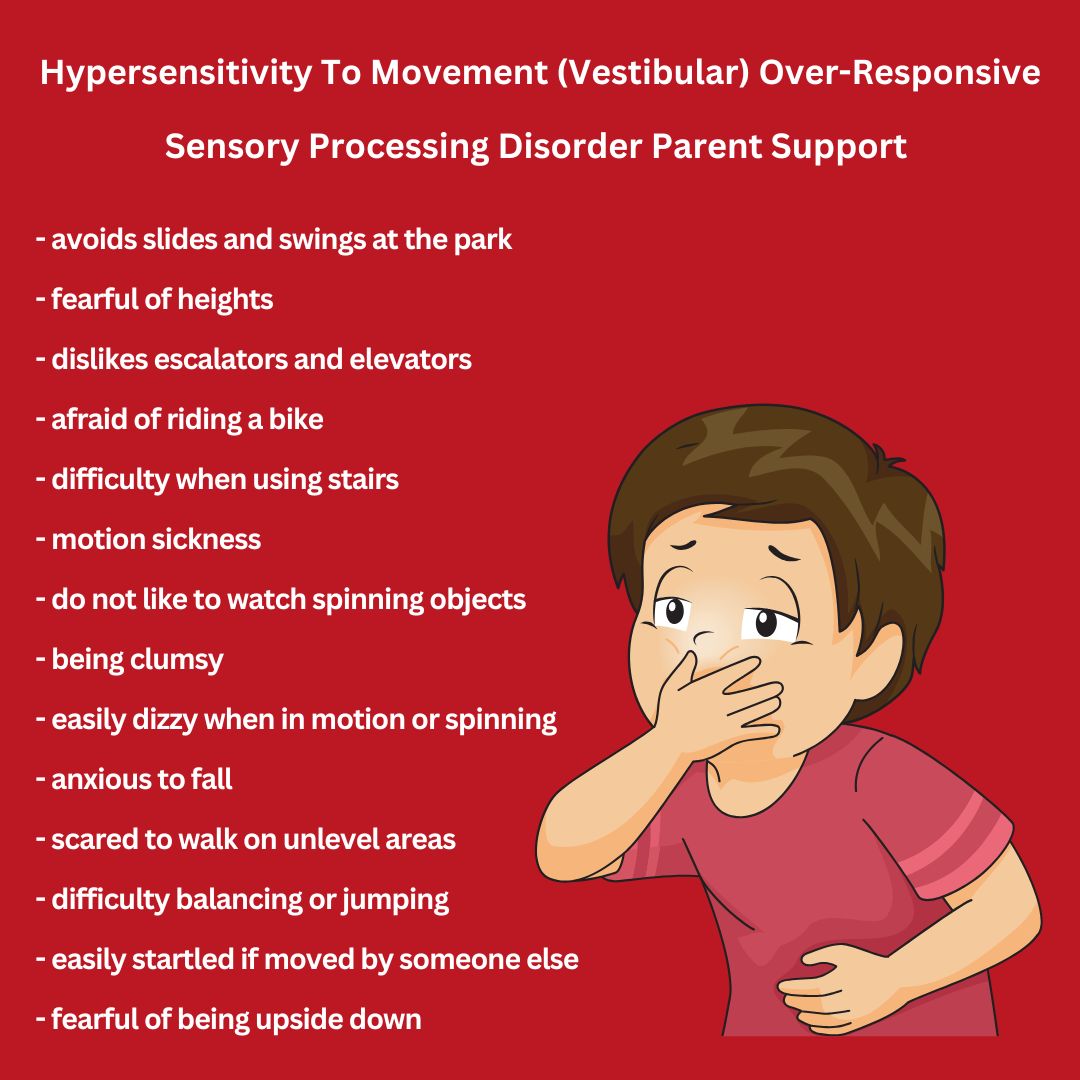
Hypersensitivity To Movement (Vestibular) Over-Responsive Sensory Processing Disorder Symptoms Checklist
- avoids slides and swings at the park
- fearful of heights
- dislikes escalators and elevators
- afraid of riding a bike
- difficulty when using stairs
- motion sickness
- do not like to watch spinning objects
- being clumsy
- easily dizzy when in motion or spinning
- anxious to fall
- scared to walk on unlevel areas
- difficulty balancing or jumping
- easily startled if moved by someone else
- fearful of being upside down
Hypo-responsiveness (proprioception) Sensory Processing Disorder Symptoms Checklist
- often fidgets
- always in constant motion
- falls often and clumsy
- has a heavy foot and stomps feet
- enjoys tight hugs and being squished under cushions
- jumps on bed and furniture
- appears to be aggressive
- purposely flops down on the floor
- frequently grinds teeth
- pushes or hits other children
- known to play rough
- struggles with fine motor skills
- prefers being wrapped up in heavy blankets
- bumps and crashes into everything
- walks on toes
- poor handwriting skills
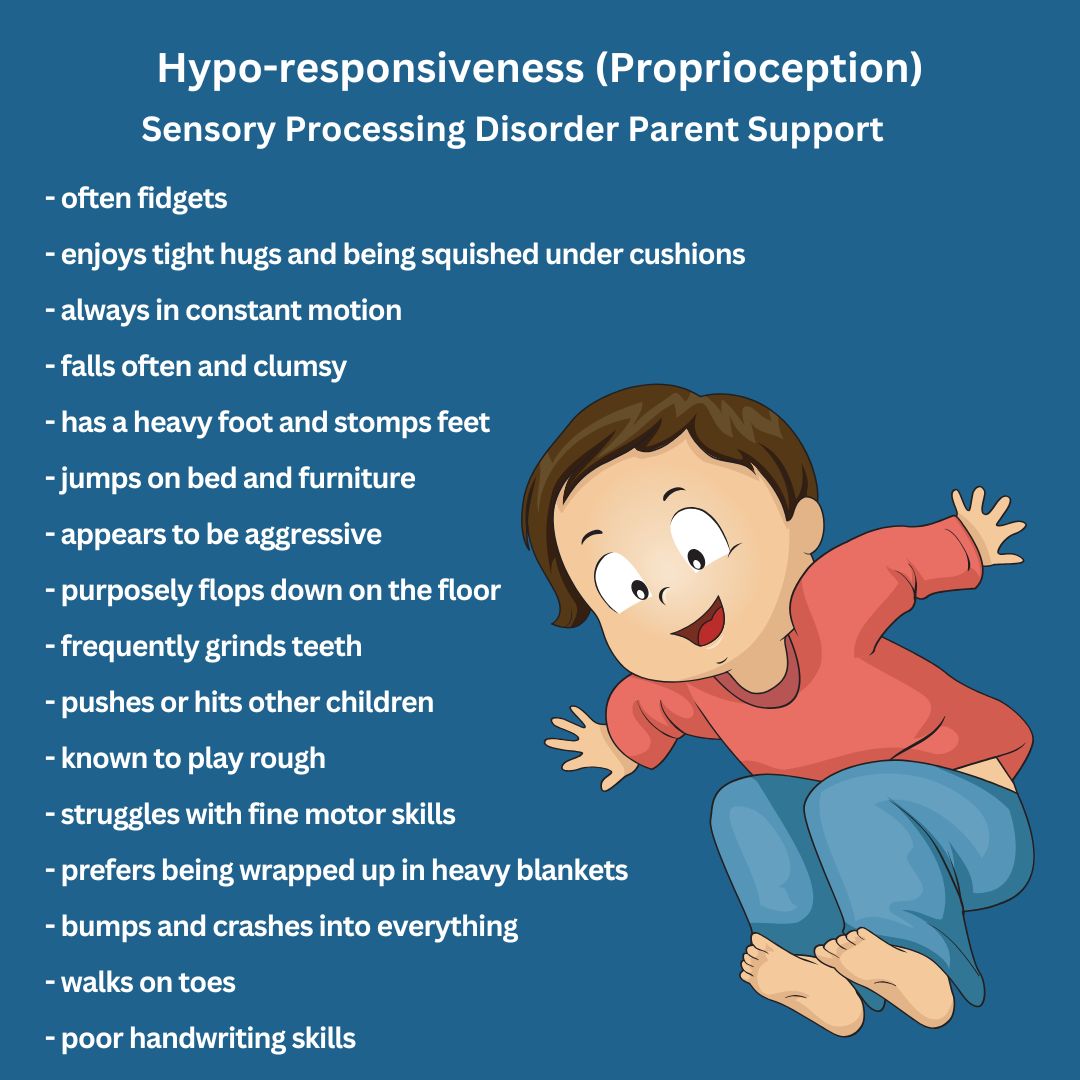
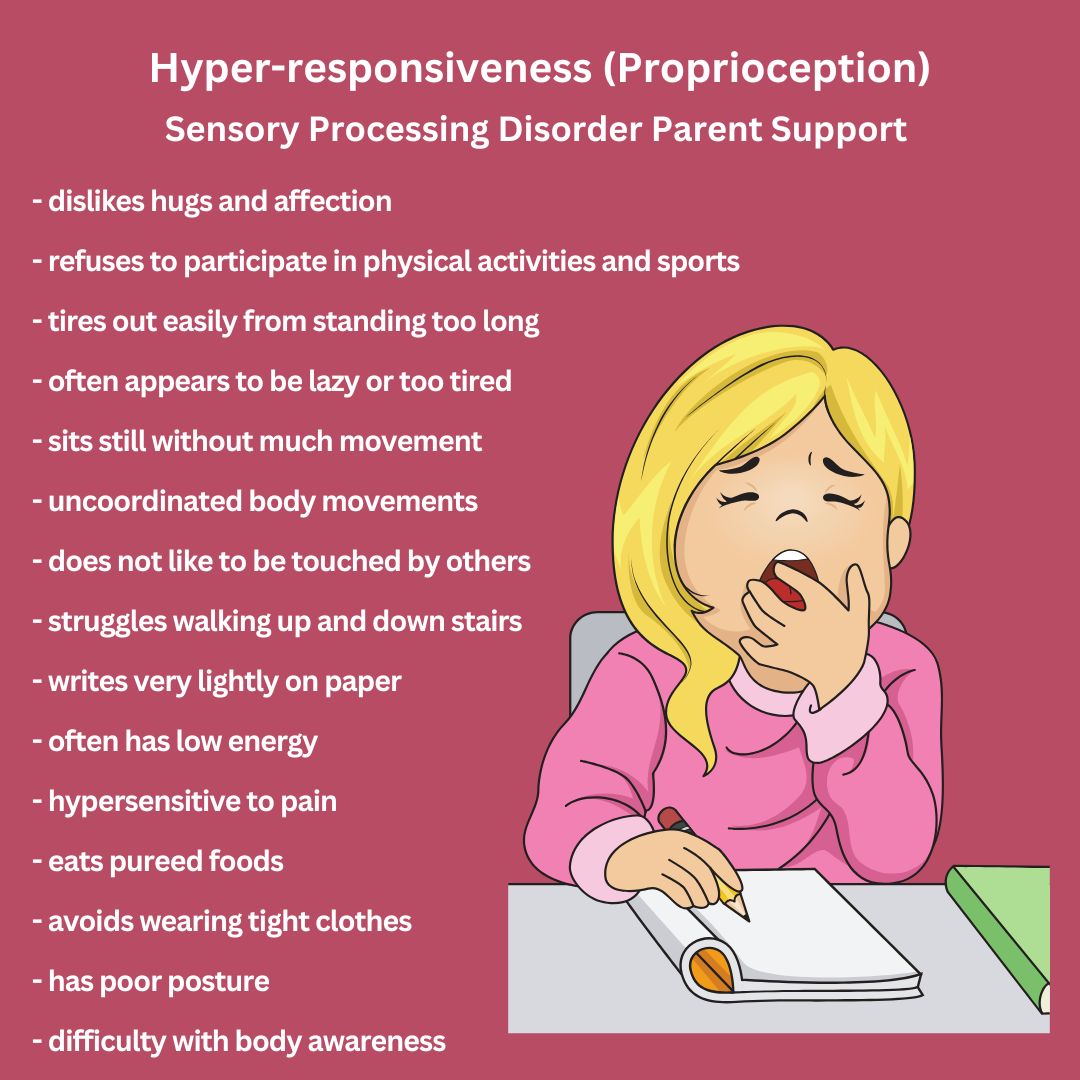
Hyper-responsiveness (Proprioception) Sensory Processing Disorder Symptoms Checklist
- dislikes hugs and affection
- often appears to be lazy or too tired
- sits still without much movement
- refuses to participate in physical activities and sports
- uncoordinated body movements
- does not like to be touched by others
- struggles walking up and down stairs
- writes very lightly on paper
- often has low energy
- tires out easily from standing too long
- hypersensitive to pain
- eats pureed foods
- avoids wearing tight clothes
- has poor posture
- difficulty with body awareness
Hypo-responsiveness (Auditory) Sensory Processing Disorder Symptoms Checklist
- enjoys making noise
- talks out loud while doing things
- says "what" often
- speaks loudly
- unaware of sounds and noises
- craves noise
- unsure where sounds and noises are coming from
- asks to repeat instructions
- frequently makes silly sounds
- likes to listen to loud music
- enjoys attending loud events
- watches television loudly
- bangs on doors
- forgets what people have said
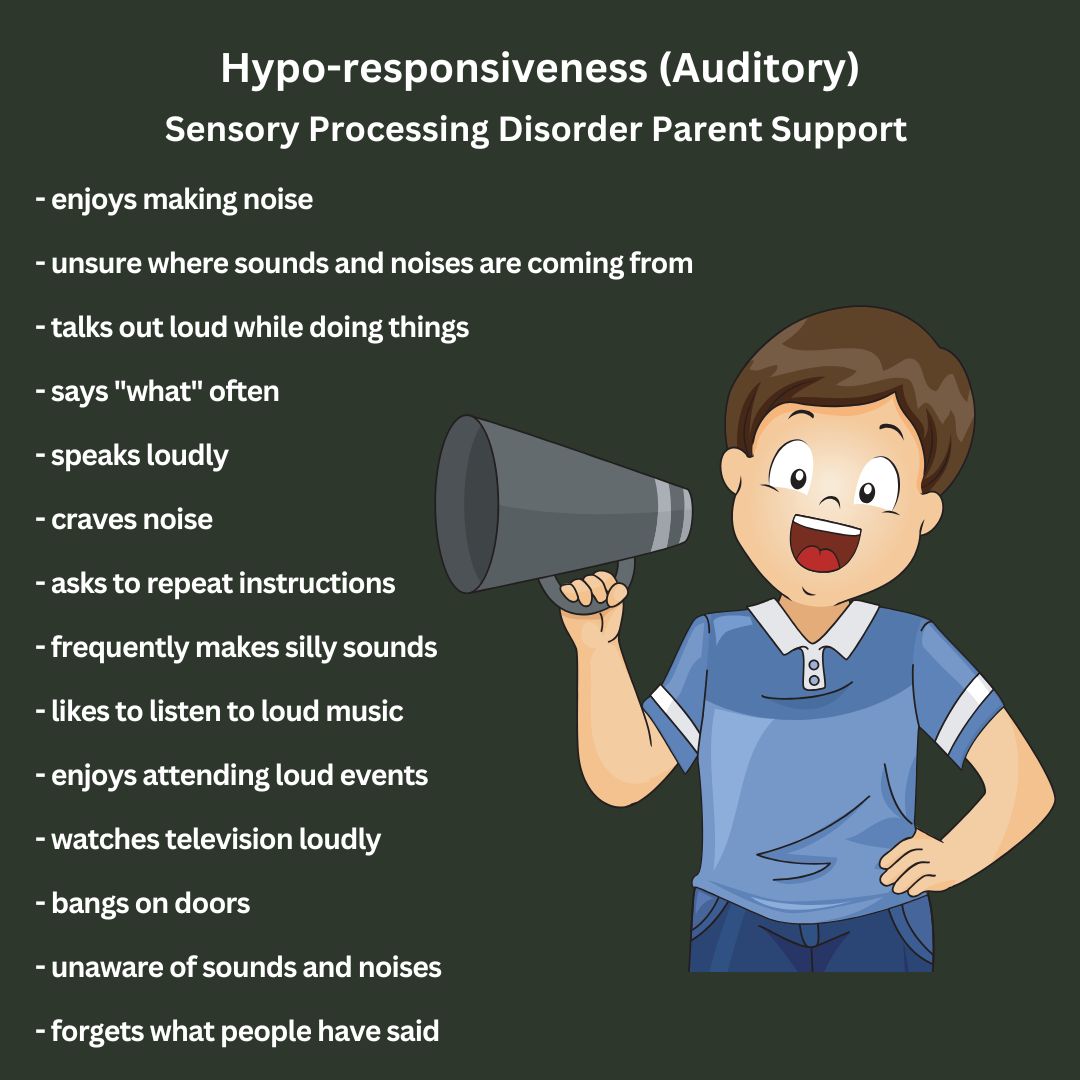
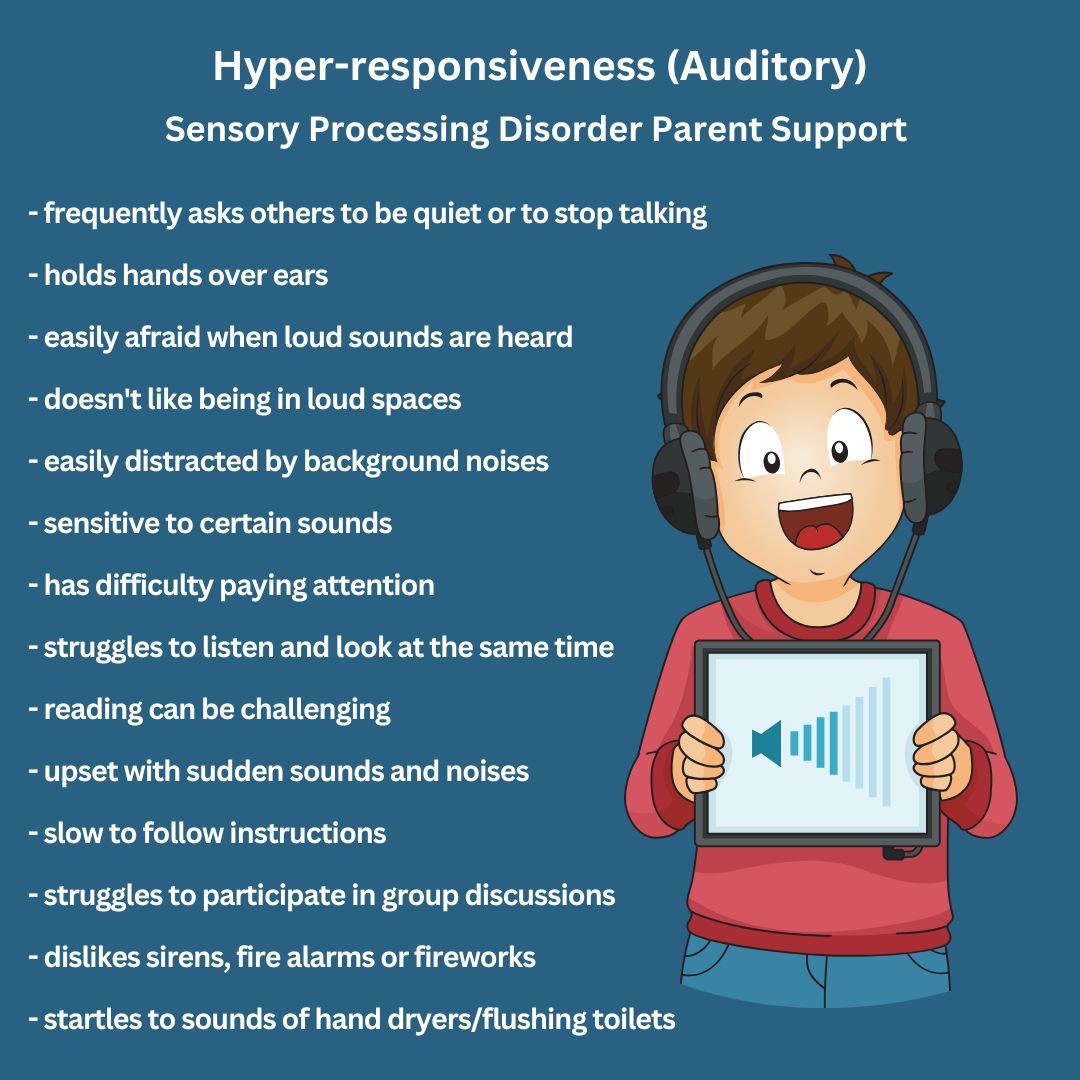
Hyper-responsiveness (Auditory) Sensory Processing Disorder Symptoms Checklist
- frequently asks others to be quiet or to stop talking
- holds hands over ears
- easily afraid when loud sounds are heard
- startles to the sounds of hand dryers and flushing toilets
- doesn't like being in loud spaces
- easily distracted by background noises
- sensitive to certain sounds
- has difficulty paying attention
- struggles to listen and look at the same time
- reading can be challenging
- becomes upset with sudden sounds and noises
- slow to follow instructions
- struggles to participate in group discussions
- dislikes sirens, fire alarms or fireworks
Hypo-responsiveness (Visual) Sensory Processing Disorder Symptoms Checklist
- has double or blurred vision
- has difficulty differentiating between similar letters (b,d)
- confuses different shapes
- struggles doing puzzles
- misunderstands left and right
- struggles with reading and writing
- easily tired while doing school work
- enjoys watching objects spin
- struggles with eye/hand coordination
- difficulty copying from books
- responds slowly to objects coming toward them
- missteps on curbs or stairs
- bumps into people and objects
- focuses on details
- struggles often to see the differences in objects/colors etc.
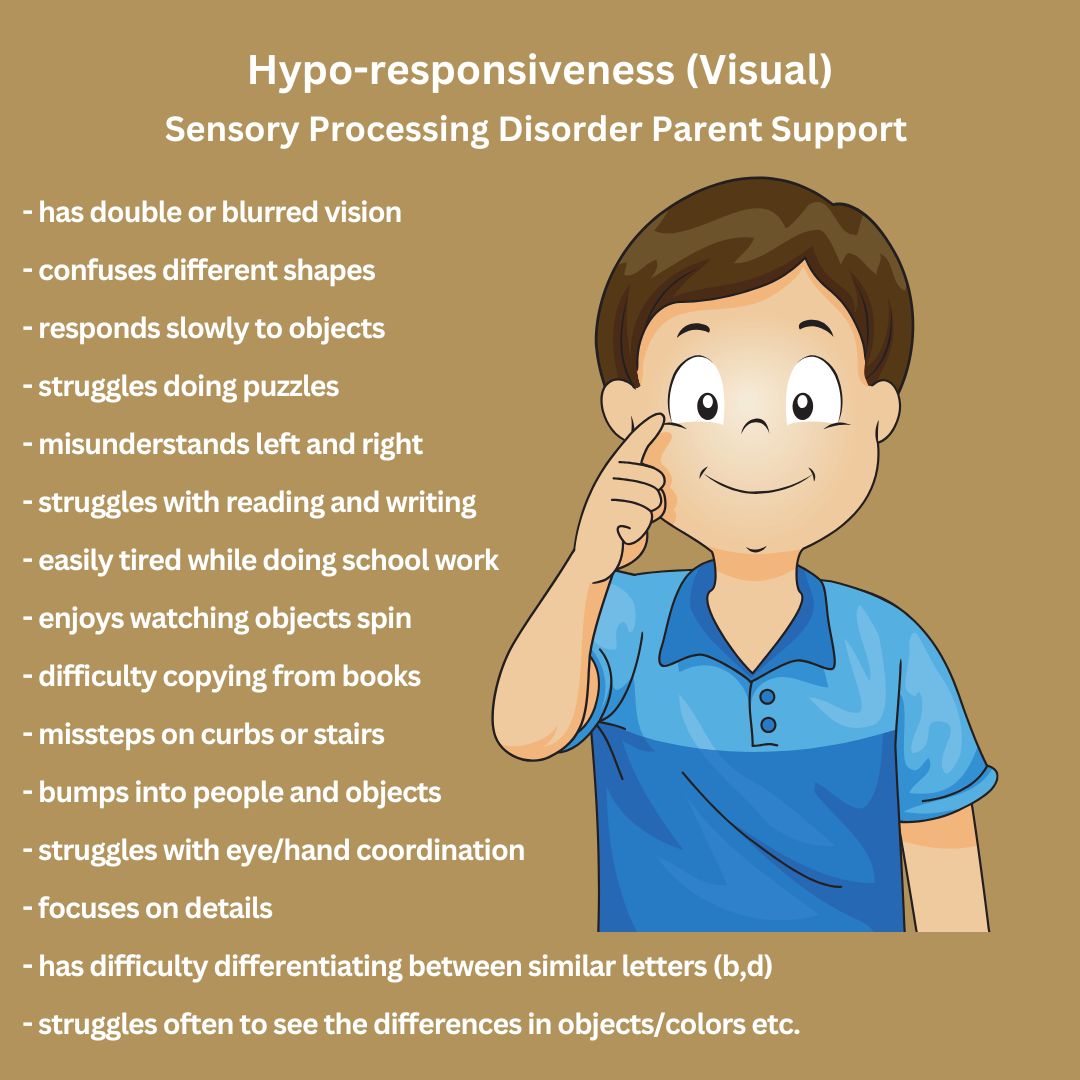
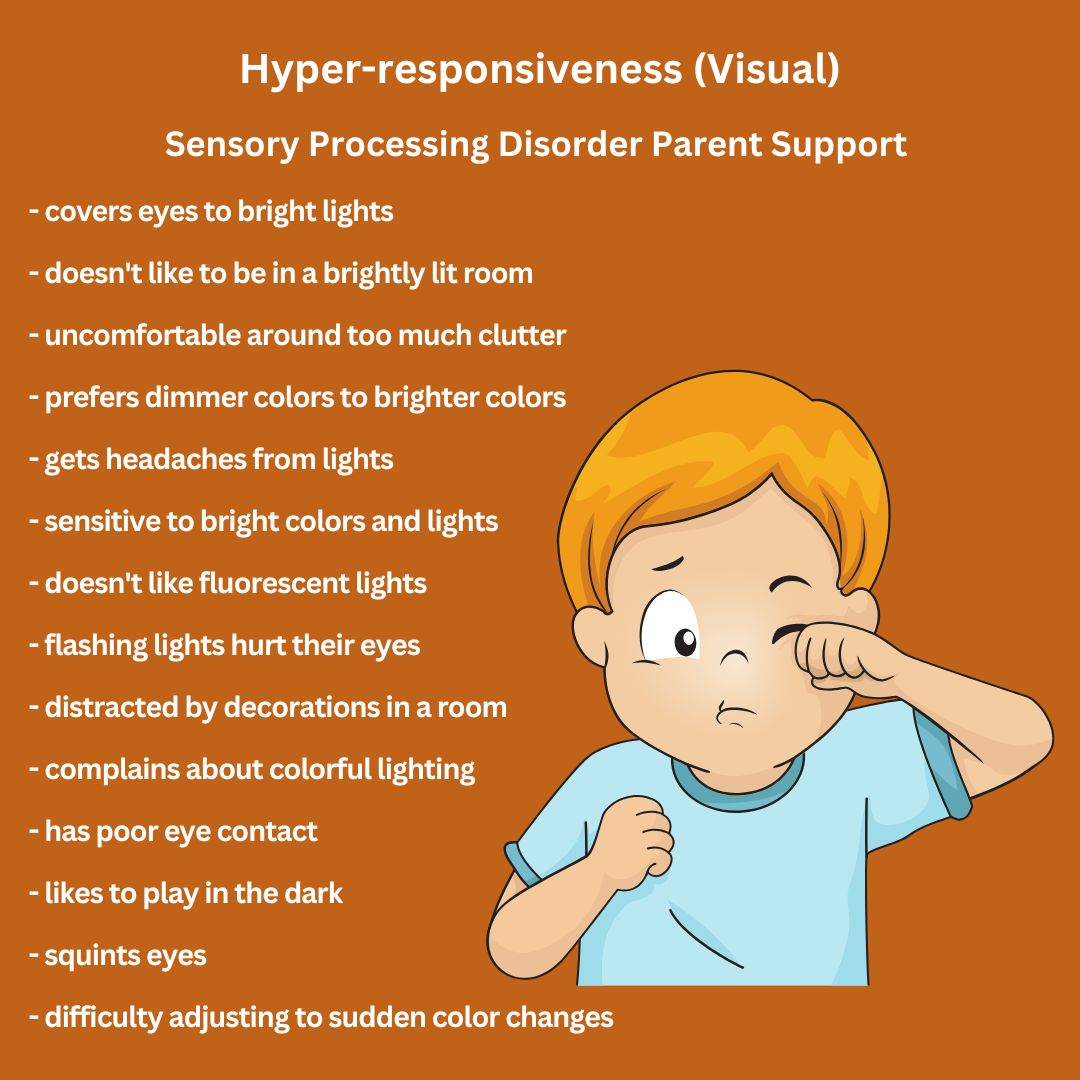
Hyper-responsiveness (Visual) Sensory Processing Disorder Symptoms Checklist
- covers eyes to bright lights
- gets headaches from lights
- squints eyes
- has poor eye contact
- likes to play in the dark
- sensitive to bright colors and lights
- difficulty adjusting to sudden color changes
- doesn't like fluorescent lights
- flashing lights hurt their eyes
- distracted by decorations in a room
- complains about colorful lighting
- doesn't like to be in a brightly lit room
- prefers dimmer colors to brighter colors
- uncomfortable around too much clutter
Hyper-responsiveness Smells (Olfactory) Sensory Processing Disorder Symptoms Checklist
- dislikes smells that others don't notice
- tells others how bad they smell
- won't eat several foods because of their smell
- doesn't like the smell of other people's homes
- complains over perfume smells
- anxious by certain smells
- pinches nostrils to avoid smelling the environment
- nauseated by certain scents
- very sensitive to the smell of what someone is cooking
- avoids places due to their smell
- rejects others because of their smell
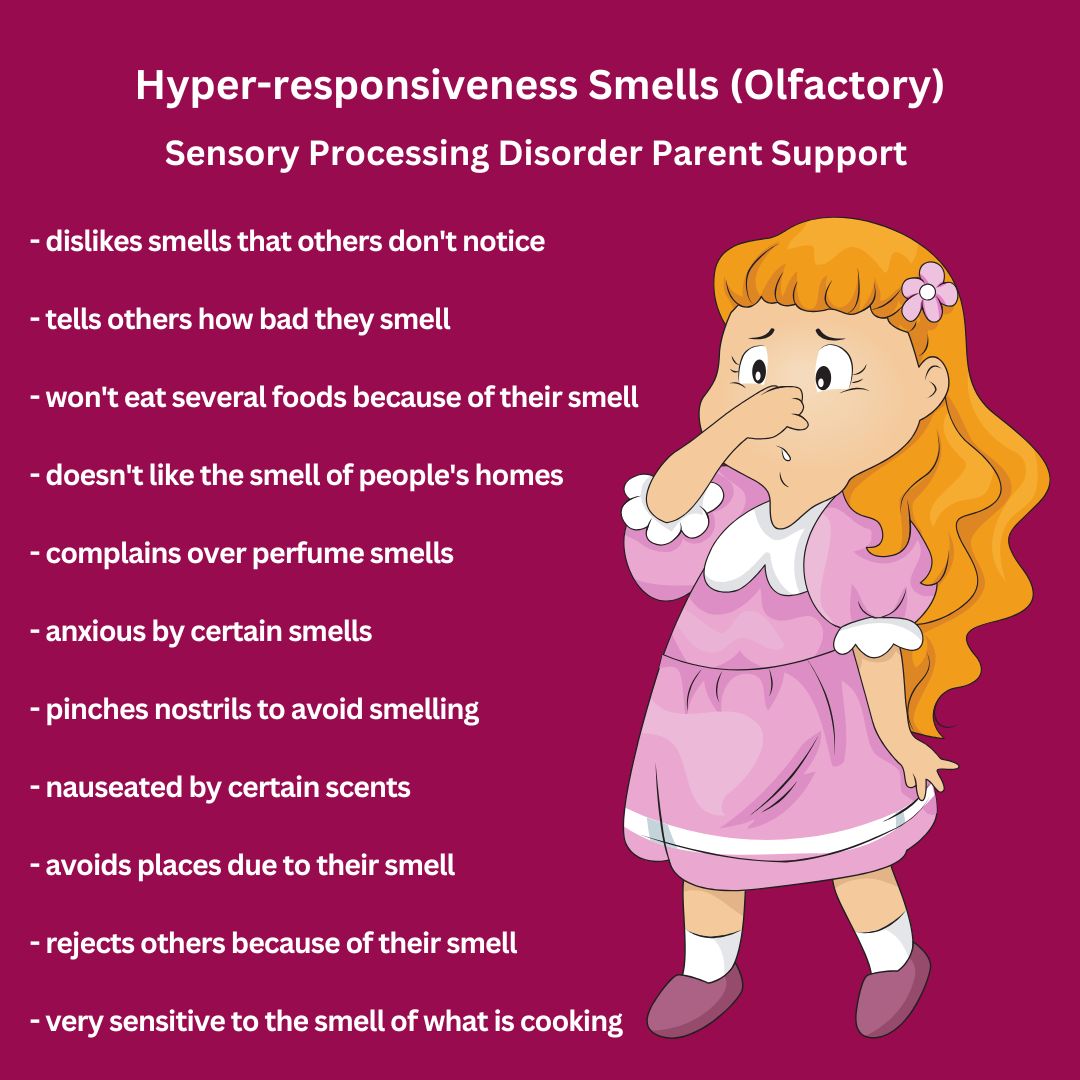
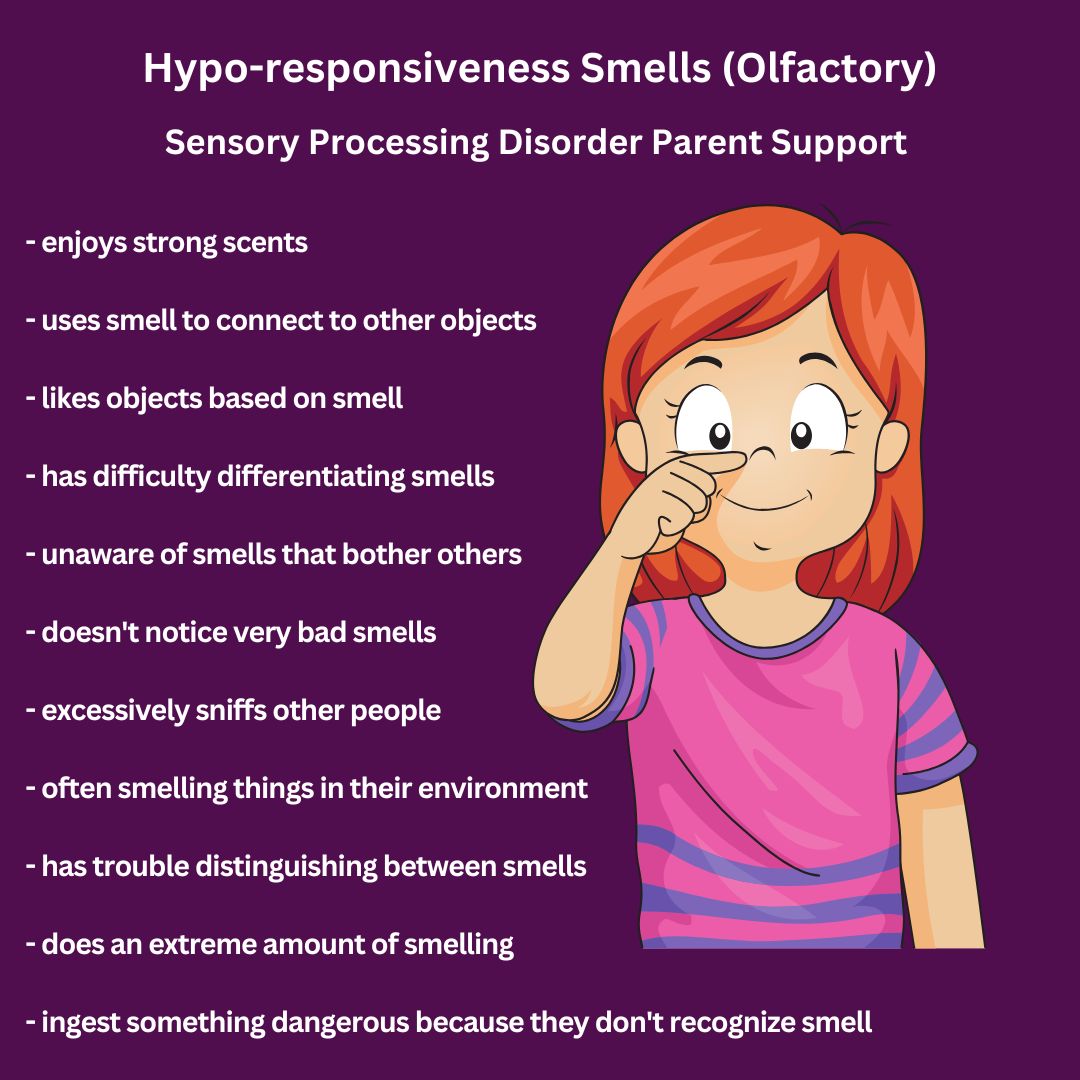
Hypo-responsiveness Smells (Olfactory) Sensory Processing Disorder Symptoms Checklist
- enjoys strong scents
- often smelling things in their environment
- likes objects based on smell
- has trouble distinguishing between smells they don't like
- ingest something dangerous because they don't recognize smell
- has difficulty differentiating smells
- unaware of smells that bother others
- doesn't notice very bad smells
- does an extreme amount of smelling in new environments
- excessively sniffs other people
- uses smell to connect to other objects
Oral Hypo-sensitive (Gustatory) Sensory Processing Disorder Symptoms Checklist
- prefers spicy and intense flavorful foods
- chews non-food items
- prefers only very hot or very cold foods
- bites other people
- chews inside their cheeks
- fills cheeks full of food
- chews on fingers or shirts
- enjoys using a vibrating toothbrush
- bites finger nails
- prefers crunchy foods
- bite their tongue and lips often
- craves certain foods
- licks objects around them
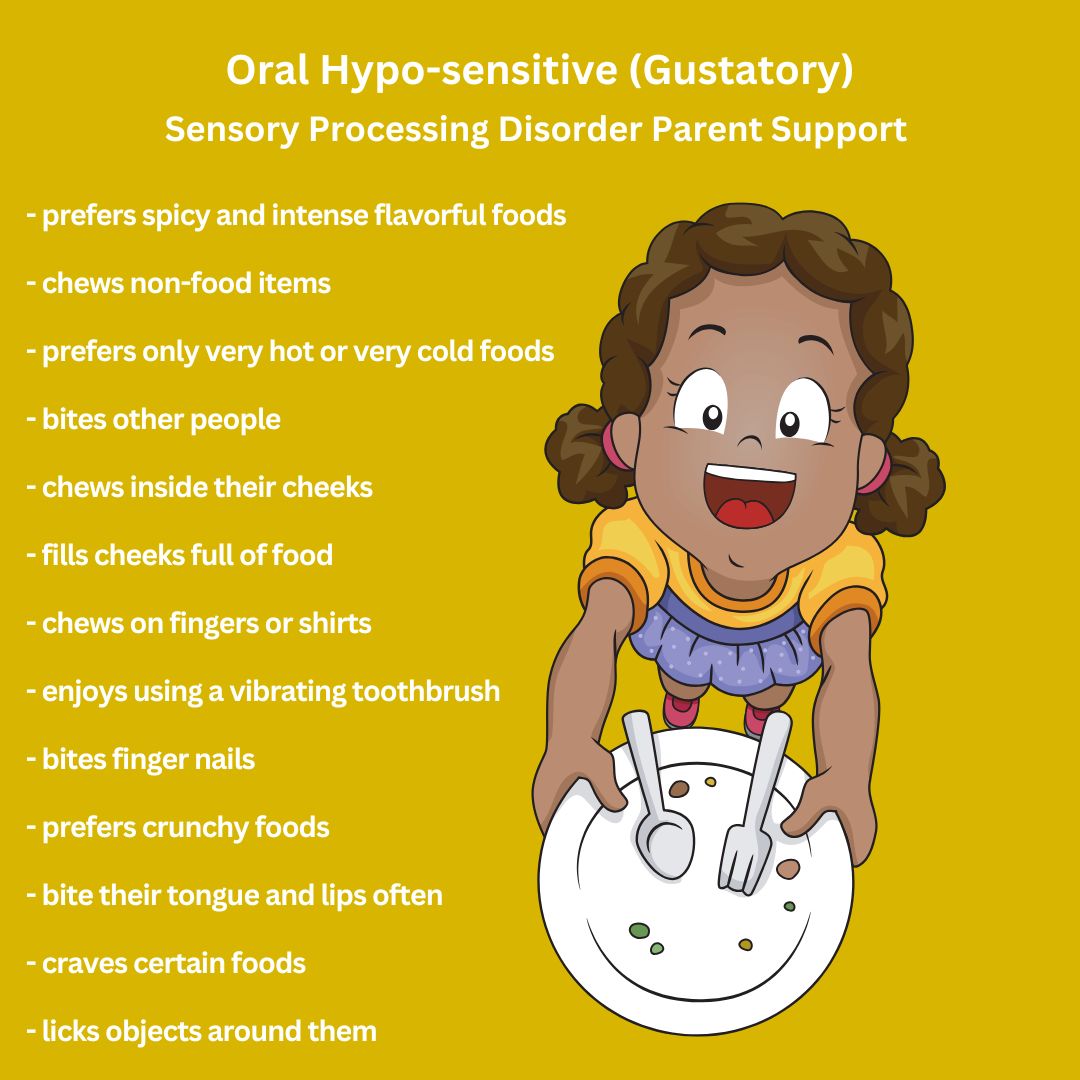
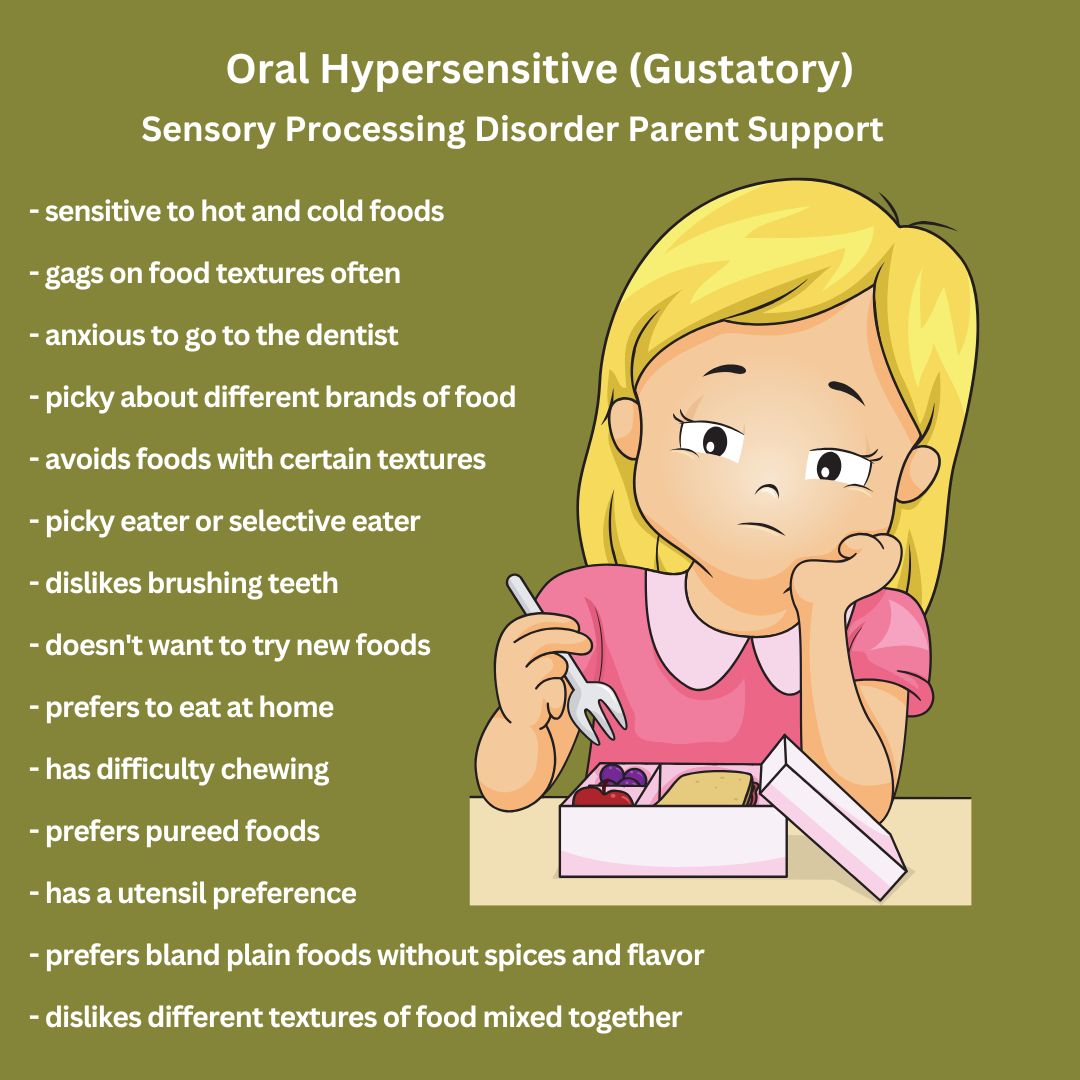
Oral Hypersensitive (Gustatory) Sensory Processing Disorder Symptoms Checklist
- sensitive to hot and cold foods
- gags on food textures often
- prefers bland plain foods without spices and flavor
- anxious to go to the dentist
- dislikes different textures of food mixed together
- picky about different brands of food
- avoids foods with certain textures
- picky eater or selective eater
- dislikes brushing teeth
- doesn't want to try new foods
- has a utensil preference (certain fork or spoon)
- prefers to eat at home
- has difficulty chewing
- prefers pureed foods
Hyper-responsiveness (Interoceptive)
- sensitive to feeling cold and hot
- unable to respond to feelings appropriately
- sensitive to the feeling of their heartbeat
- easily overwhelmed when they feel stress
- low pain tolerance
- often feels hungry or thirsty
- overeats and overdrinks and not usually feeling full
- uses the bathroom often and feeling they always need too
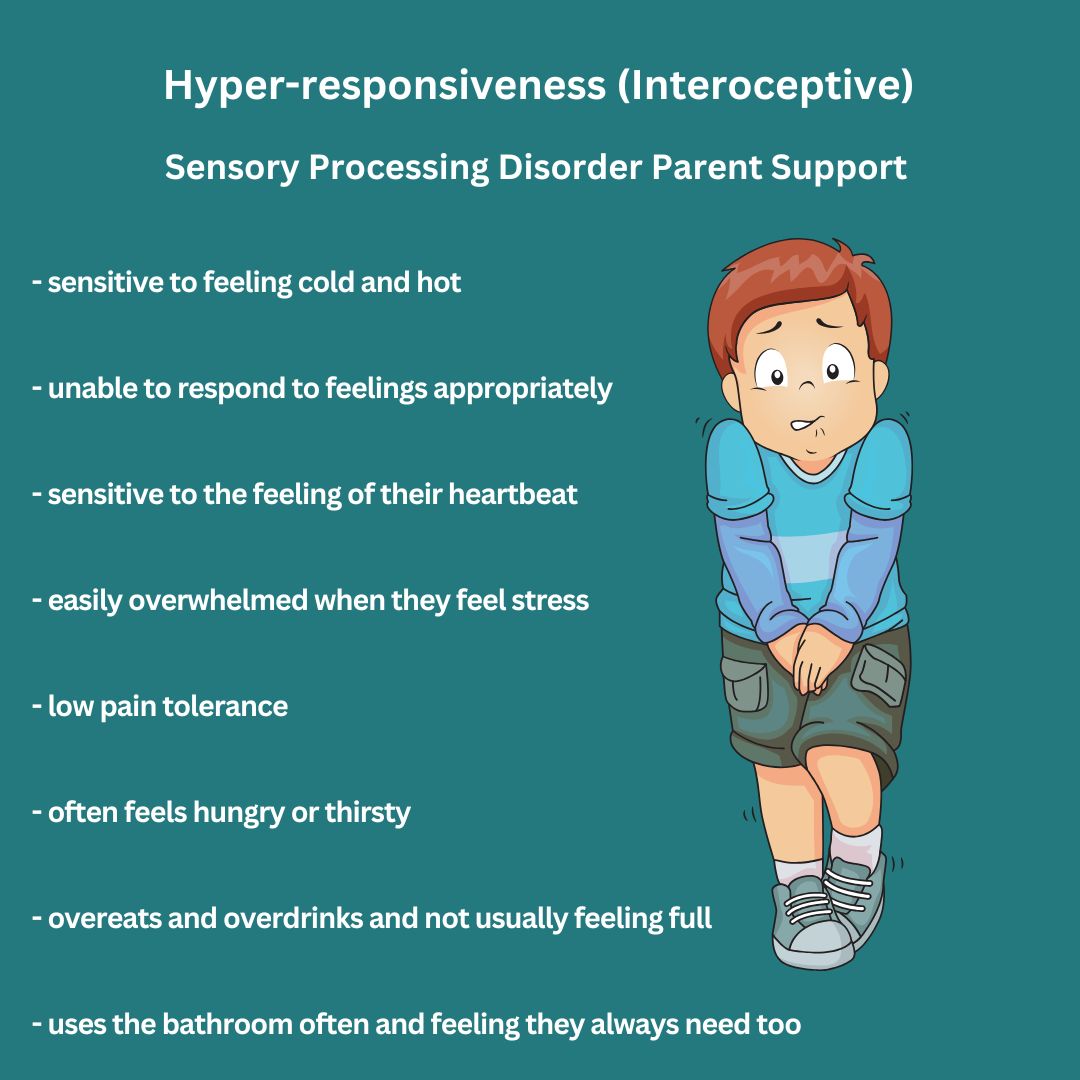

Hypo-responsiveness (Interoceptive) Sensory Processing Disorder Symptoms Checklist
- they don’t tell you if they are thirsty or hungry
- difficulty going to sleep
-struggles with potty training
- don't mention when they feel unwell
- may not react to cold and hot
- struggles with toilet training
- doesn’t often drink or eat enough
- high pain tolerance
- they don’t often know when they need the bathroom
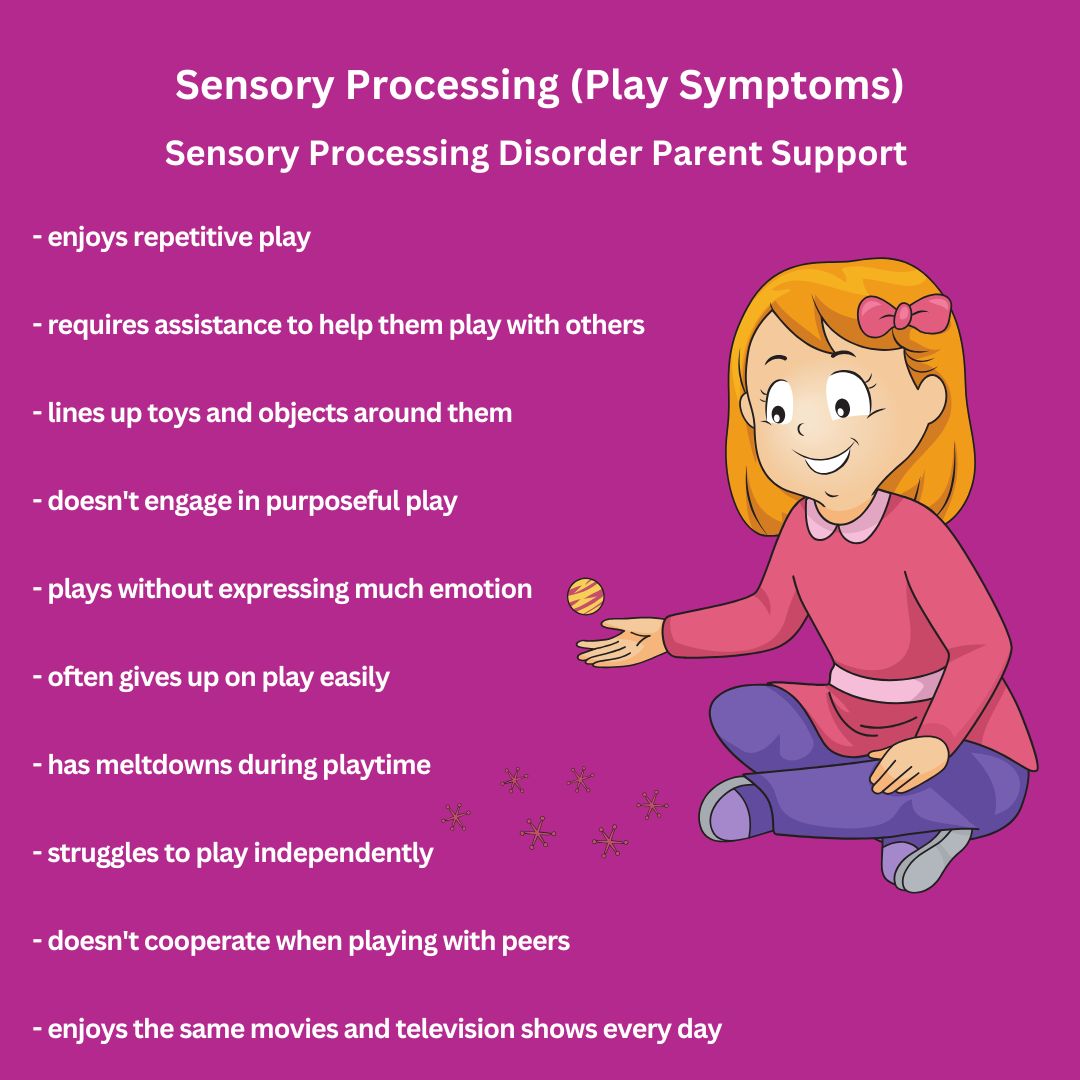
Sensory Processing Disorder (Play Symptoms) Sensory Processing Disorder Symptoms Checklist
- struggles to play independently
- enjoys repetitive play
- requires assistance to help them play with others
- lines up toys and objects around them
- enjoys the same movies and television shows every day
- doesn't engage in purposeful play
- plays without expressing much emotion
- often gives up on play easily
- has meltdowns during playtime
- doesn't cooperate when playing with peers
Sensory Processing Disorder (Social Symptoms) Sensory Processing Disorder Symptoms Checklist
- difficulty having conversations with children their age
- Abusive towards themselves and friends
- struggles to get along with their friends
- enjoys playing alone
- difficulty interacting with peers
- two way conversations are challenging
- peers find it difficult to understand their needs
- struggles to initiate conversation
- easily upset when playing with other children
- difficulty making friends
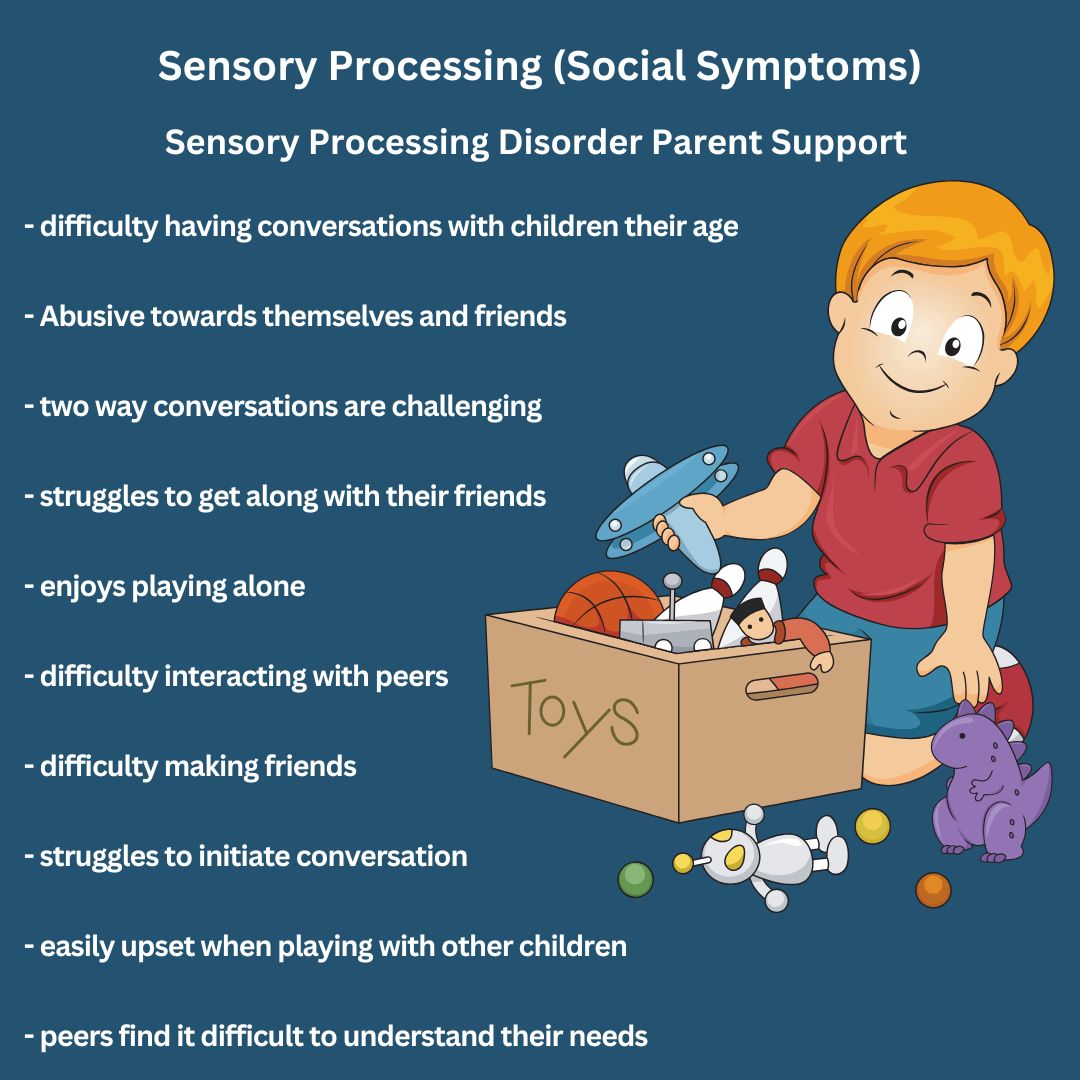
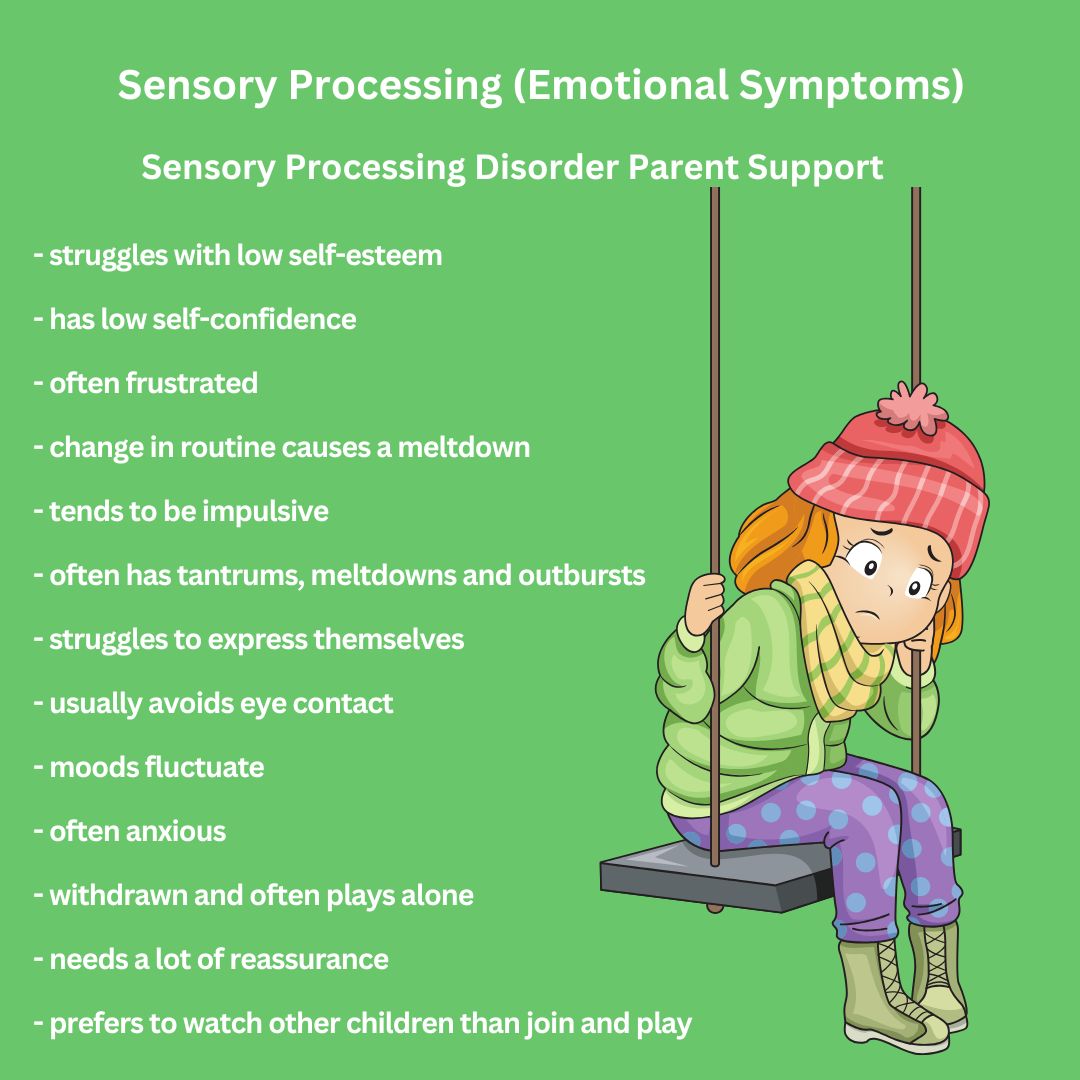
Sensory Processing Disorder (Emotional Symptoms) Sensory Processing Disorder Symptoms Checklist
- struggles with low self-esteem
- has low self-confidence
- often frustrated
- change in routine causes a meltdown
- tends to be impulsive
- often has tantrums, meltdowns and outbursts
- struggles to express themselves
- usually avoids eye contact
- moods fluctuate
- often anxious
- withdrawn and often plays alone
- needs a lot of reassurance
- prefers to watch other children than join and play
Resources For Parents
Sensory Kids Pediatric Therapy CHECKLIST FOR SENSORY PROCESSING DISORDER (ALL AGES)
DISCLAIMER: I have learned a lot over the years but I am still learning. Always do your own research and exercise sound judgment. I am not an occupational therapist or a physician. I am an adult who has sensory processing disorder, a sensory parent and a Grandma. The information on this website is not medical advice and does not replace the information that your child's therapists or medical professionals give you. These are just ideas that I have learned myself over the years of being a parent and an adult living with SPD. If you are concerned for your child, please always seek medical attention through a family doctor, pediatrician or therapist. This website is for awareness purposes only. Each child is different and what works for one child may not for another because all children have different sensory needs. Please always consult with a medical professional. C lick on links throughout each page for more resources and information. Click here for more resources https://sensoryprocessingdisorderparentsupport.com/sensoryprocessingdisorderresources
Amazon offers a small commission on products sold through their affiliate links on my website. Each of your purchases through links on my website for Amazon affiliation links or sponsored links support me but no additional cost to you so thank you. I appreciate it so much! I am not responsible should you purchase anything from any links on this website.
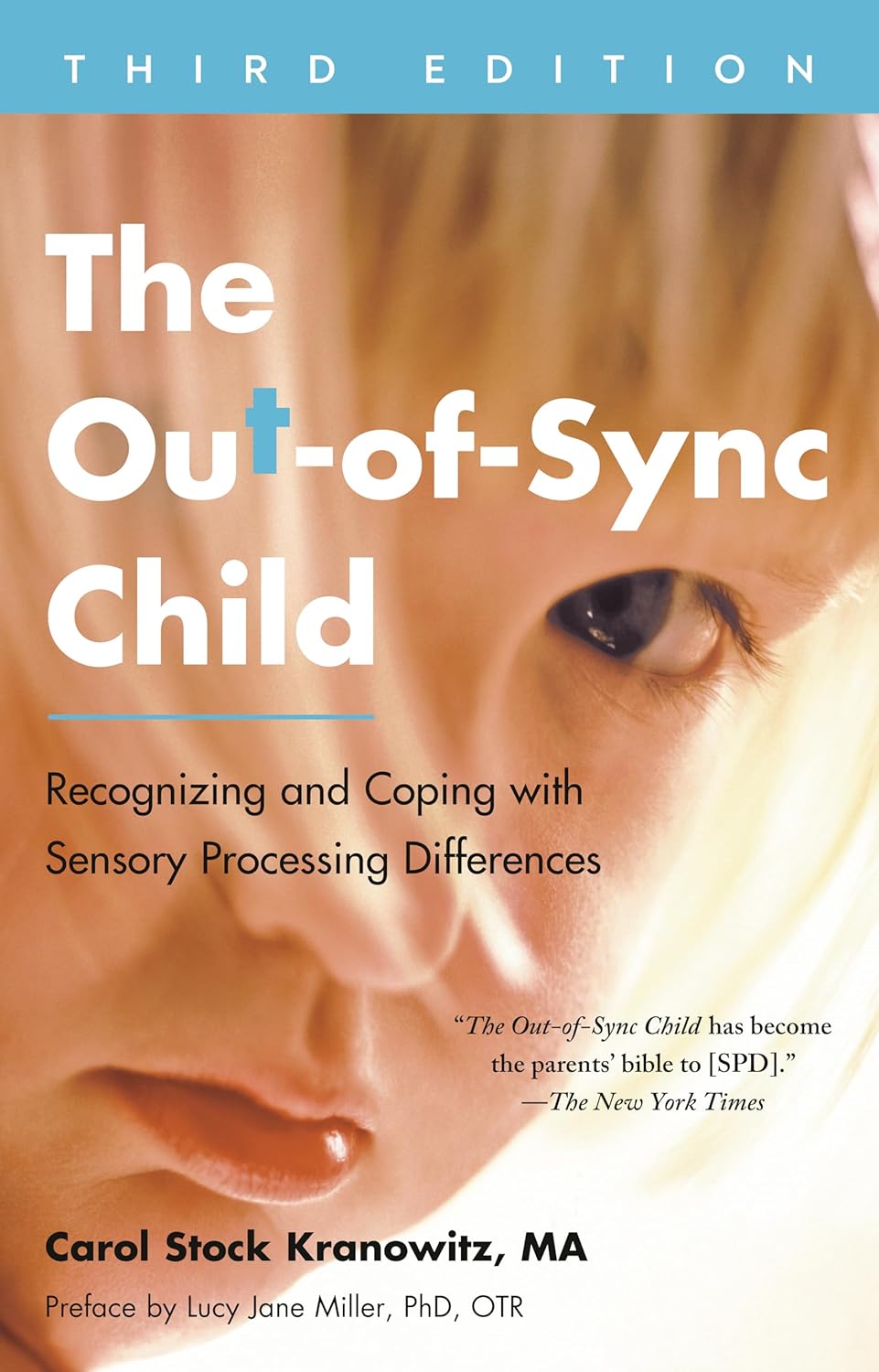
Amazon
The Out-of-Sync Child
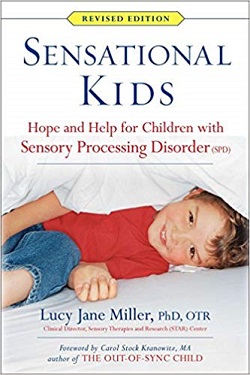
Amazon
Sensational Kids: Sensory Processing Disorder
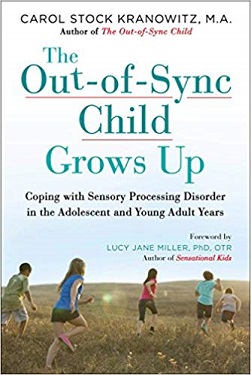
Amazon
The Out-of-Sync Child Grows Up
